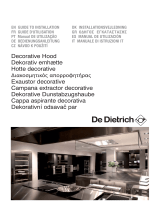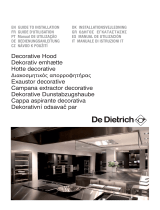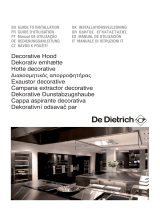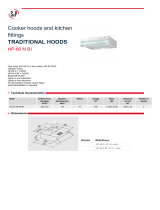Brandt DHD109WE1 Owner's manual
- Category
- Cooker hoods
- Type
- Owner's manual

Hotte décorative
Chimney cooker hood
Page is loading ...
Page is loading ...
Page is loading ...
Page is loading ...
Page is loading ...
Page is loading ...
Page is loading ...
Page is loading ...
Page is loading ...
Page is loading ...
Page is loading ...

13
USE and INSTALLATION of your COOKER HOOD
Use
A. THE LAYOUT OF YOUR HOOD P.14
B. WHEN
TO CLEAN YOUR HOOD
P.15
- Regular cleaning
- Monthly cleaning (cleaning the cartridge filter)
- Annual cleaning (fitting the activated carbon filter
for the recirculation model)
C. C
HANGING THE
BULBS P.16
- Model using light bulbs or neon tubes (cover)
- Models with halogen lighting.
Installation
A. GENERAL POINTS P.17
B. DIMENSIONS
P.17
C. FITTING
P.18-20
- 1) Pre-fitting recommendations.
- 2) Fitting the hood canopy.
- 3) Electrical connection.
- 4) Fitting the chimney.
a) Venting to the outside.
b) Recirculation.
YOUR AFTER SALES SERVICE P.20
Dear Sir or Madam
Congratulations on purchasing one of our cooker hoods.
To obtain the greatest possible satisfaction from your new appliance, we advise you to read very carefully the
information contained in this booklet before installing or using it.
FOR YOUR SAFETY
- Never flame dishes or operate gas burners under the hood without placing a pan on them
(the flames will be drawn upwards and may damage the appliance).
- Deep frying carried out under the hood must be kept under constant supervision.
- Repairs must only be carried out by an approved specialist.
- Clean the cartridge filter regularly (about once a month).
- Use of the hood over a solid fuel stove (wood, coal, etc.) is not permitted.
As your appliance has been installed by a De Dietrich approved specialist in accordance with the instructions in the
installation section of this booklet, we recommend that you read the following pages carefully to enable you to get the
best from your De Dietrich cooker hood.
These cooker hoods have been designed for private use in the home.
With a view to the constant improvement of our products, we reserve the right to make any changes in
their technical, functional or aesthetic characteristics as a result of technical evolution.
These cooker hoods are designed exclusively for the cooking of drinks and foodstuffs. These products
do not contain any asbestos-based component parts.

14
II
II
NN
NN
SS
SS
TT
TT
RR
RR
UU
UU
CC
CC
TT
TT
II
II
OO
OO
NN
NN
SS
SS
FF
FF
OO
OO
RR
RR
UU
UU
SS
SS
EE
EE
Light
(page 4)
Cartridge filter
(page 3)
Control buttons
(see below)
A. THE LAYOUT OF YOUR COOKER HOOD
INSTRUCTIONS FOR USE
Low speed :
- for simmering and dishes which do not produce much steam,
- to ventilate the kitchen.
Medium speed
:
- for standard cooking operations.
Maximum speed :
for when large amounts of smoke or steam are being produced (deep frying, pressure cooking...).
Always return to medium speed as soon as possible.
For maximum efficiency from your hood :
Use the rear cooking areas on your cooker in preference.
- We advise you to turn the extractor hood on as soon as you start cooking and if necessary keep it running for a
few minutes after you have finished cooking.
NB :
Change the air in the room often by ventilating it as much as possible.
Note that at high speed the volume of air in a kitchen is changed within a few minutes.
IMPORTANT
- If the kitchen is heated by an appliance connected to a chimney (for example: a solid fuel stove or cooker...), a
recirculation type hood must be installed (see Installation section p. 8).
- Do not use the hood without the metal filters.
3 speed model
1 Low speed
2 Medium speed
3 High speed
Lighting
Important : when several speed buttons have been
pushed in, the highest speed is selected.
The hood is turned off when none of the buttons
is pushed in.

Never use metal scouring pads, abrasive cleaning products or very stiff brushes.
For cleaning the bodywork and the light cover, use a commercial household cleaning product exclusively, diluted
with water, then rinse with clean water and dry with a soft cloth.
ESSENTIAL : clean these filters every month to prevent any risk of fire.
The filter collects greasy smoke and dust and is an element which plays an important role in the efficiency of your
extractor hood.
It can become inflammable when it is saturated with greasy residues.
Clean it with a commercial household cleaning product, then rinse well and dry.
This cleaning can be done in your dishwasher, with the filter in an upright position (do not allow it to come into
contact with dirty dishes and pans).
Before using the cartridge filter for the first time, remove the protective film.
- To take off the cartridge filter
1. Push it back, supporting it with one hand 2.. Then pivot the filter downwards
After cleaning, replace the filter, carrying out the same operations in reverse order.
Applies SOLELY to extractor hoods installed as a recirculation unit (not vented to the outside).
This filter traps odours and must be changed at least once a year depending on how much it is used.
Order these filters from your dealer (using the reference number shown on the identification plate inside the hood)
and keep a note of the date it was changed.
1. Remove the cartridge filters.
2. Insert the 2 activated carbon filters (foam) as
shown in the diagram.
3. Replace the cartridge filters.
Motor
Location of the
filter
Carbon filter (foam)
15
B. WHEN TO CLEAN YOUR HOOD
1) REGULAR CLEANING
2) MONTHLY CLEANING : cartridge filter
3) ANNUAL CLEANING : activated carbon filter

16
1. Unscrew the screw securing the light cover.
2. Tip it back.
3. - Model using type E14 40 W light bulb,
change the bulb by unscrewing it and screwing
in the new one.
- Model with type G23-11 W neon tube:
(see diagram opposite)
4. Replace the light cover.
5. Screw back the light cover.
1. Remove the chrome rims "A" by turning them
anti-clockwise.
2. Change the type GU 5.3-60° -20 W - 12 V
halogen lamps "B" by pulling them downwards.
3. Replace the assembly by carrying out the
operations in reverse order.
B
A
1/4
B
A
Before carrying out any maintenance work, isolate the cooker hood from the power source,
either by pulling out the plug, if it is accessible, or by switching off at the cut-off switch.
A. Pull the neon tube to the left.
B. Take it out of its socket.
C. CHANGING THE BULBS
:
MODEL USING LIGHT BULB OR NEON TUBE
MODEL WITH HALOGEN LIGHTING

17
Length: 600 or 900 mm according to model
Depth: 500 mm
Total height without duct: 285 mm
Total height: 910 / 1225 mm
External diameter of outlet: 150 mm (with check valve) or 125 mm.
If you do not have an outlet to the outside:
All our appliances have the option of operating in
recirculation (with no outlet to the outside).
Under these circumstances, add an activated
carbon filter which will trap odours (see illustration
p. 5).
These filters are available from your dealer under
the reference indicated on the identification plate
(see inside hood).
If you have an outlet to the outside:
Your cooker hood can be connected to this by means of an
extraction duct (enamel, aluminium, flexible pipe or non-flammable
material with an interior diameter of 150 mm) (not supplied).
An adapter enables you to connect your hood to an extraction
duct with an interior diameter of 125 mm (supplied with your
hood).
NB: for optimum use of your appliance, we recommend
connection to a duct with a diameter of 150 mm.
MODEL WITH VENTING TO THE OUTSIDE
MODEL USING RECIRCULATION
minimum 125
maximum 440
I
I
N
N
S
S
T
T
A
A
L
L
L
L
A
A
T
T
I
I
O
O
N
N
A. General points
B. Dimensions :
min. 910 - max. 1225
600 or 900

18
- Draw a vertical line on the wall to centre your hood (and its chimney) correctly over your cooker.
- Make a mark on the vertical line 70 cm above your hob surface.
This vertical line and the mark at 70 cm will help you to position correctly the fitting template supplied.
- Place the fitting template against the wall: align the vertical line on the wall with the "centreline of the hood"
indicated on the template.
- Drill 4 holes with a diameter of 8 as shown on the template.
- Fix the two brackets onto the wall using the 4 screws and rawlplugs supplied with the appliance (fig. 1).
Note: in the case of a cavity wall, use appropriate screws and rawlplugs.
- Remove the cartridge filters.
- Hook on the hood by its rectangular cut-outs. The size of these cut-outs allows for adjustment to the left or the
right.
IMPORTANT :
- The height is adjusted by manoeuvring the adjuster screws "A" on the brackets (fig. 1).
- The depth is adjusted by altering screw "B" (fig. 1).
This appliance is supplied with an H 05 VVF power supply cable with 3 cores of 0.75 mm
2
(2 phase + earth) and
should be connected to the 230 V single phase mains supply by means of a plug and socket complying with the
EEC 7 standard or a double pole isolator switch with a contact gap of at least 3 mm. This double pole cut-off
device will also be required if the socket is not accessible.
We will not be liable in the event of any accidents resulting from incorrect or non-existent earthing.
Your mains fuse should be 10 or 16 amp.
fig. 1
C. Fitting
1) Pre-fitting recommendations :
2) Fitting the hood canopy :
3) Electrical connection
:
(cross head
leng: 25 mm)
(hexagonal head
leng: 8 mm)

19
a) Using venting to the outside
Installation must comply with current regulations for the ventilation of premises.
In particular, the extracted air must not be carried into a duct used for ventilation, hot air circulation or smoke
extraction.
If the cooker hood is to operate using venting to the outside, provision must be made for a fresh air supply
sufficient to prevent the room coming under negative pressure.
Old, disused ducts can only be used with the agreement of a qualified specialist.
- Fit the check valves (fig. 2)
- Fix the metal support bracket for the chimney to the wall, resting against the ceiling (fig. 3). Take care to align the
2 triangular notches on the metal bracket with the vertical line drawn on the wall (drill 8 in diameter, 2 screws and
rawlplugs supplied).
- Fix the extraction duct, diameter 150 mm, (not supplied) in place between the chimney bracket and the hood.
- When using ducting of 125 mm diameter, use the adapter supplied (fig. 4).
- Prepare your telescopic chimney, taking care to conceal the outlet holes (fig. 5).
- Fix the upper part of the chimney to the metal bracket using the screws supplied (to facilitate fitting, pull the
chimney away slightly to insert the two protuberances into the metal bracket).
- Adjust the length of the telescopic chimney.
- Insert the lower part of the chimney into the top of the hood.
fig. 2
fig. 4
fig. 3
fig. 5
inner
TUBE Ø 150
fixing point for chimney
top of hood
triangular notches
4) Fitting the chimney
:

b) Using recirculation :
- You do not need to fit the check valve.
- Fix the plastic smoke deflector to the wall, against the ceiling (drill holes with diameter of 8, 2 screws and
rawlplugs supplied) (fig. 6).
- Take care to centre the deflector in relation to the vertical line drawn on the wall.
- Fix in place the extraction duct (diameter 150, not supplied) between the deflector and the hood.
- Prepare your chimney, taking care to place the outlet holes at the top, so that they are visible (fig. 7).
- Fix the upper part of the chimney to the plastic deflector using the screws supplied (to facilitate fitting, pull the
chimney away slightly to insert the two protuberances into the plastic deflector).
- Adjust the length of the telescopic chimney.
- Insert the lower part of the chimney into the top of the hood.
fig. 6
fig. 7
chimney supports
top of hood
Appearance defects, caused by abnormal use or by cleaning with abrasive products, which do not lead to
functional anomalies or to the unit being unfit for use, are not taken into account by the manufacturer.
All repairs must be carried out by a qualified technician.
The distributors of our make are the only people who:
•
•
Have full knowledge of your appliance and its operation,
Have full knowledge of your appliance and its operation,
•
•
Fully employ our techniques of adjustment, maintenance and repair,
Fully employ our techniques of adjustment, maintenance and repair,
•
•
Use exclusively genuine spare parts
Use exclusively genuine spare parts
In the event of a complaint or to order spare parts from your distributor, give him the complete reference details for
your appliance (appliance model and serial number).
This information appears on the identification plate fixed to the interior of the appliance.
The descriptions and technical data which appear in this booklet are for information only and are not legally
binding. In the interests of product quality, we reserve the right to carry out any necessary changes and improve-
ments without prior notice.
GENUINE SPARE PARTS: ask your dealer to use only GENUINE CERTIFIED SPARE PARTS
when carrying out a repair.
A
A
f
f
t
t
e
e
r
r
s
s
a
a
l
l
e
e
s
s
s
s
e
e
r
r
v
v
i
i
c
c
e
e
If necessary, make some notches
for the power cable to p
ass through.
99538183 03/00
-
 1
1
-
 2
2
-
 3
3
-
 4
4
-
 5
5
-
 6
6
-
 7
7
-
 8
8
-
 9
9
-
 10
10
-
 11
11
-
 12
12
-
 13
13
-
 14
14
-
 15
15
-
 16
16
-
 17
17
-
 18
18
-
 19
19
-
 20
20
Brandt DHD109WE1 Owner's manual
- Category
- Cooker hoods
- Type
- Owner's manual
Ask a question and I''ll find the answer in the document
Finding information in a document is now easier with AI
in other languages
Related papers
-
Groupe Brandt AD286XT1 Owner's manual
-
Brandt AD289XT1 Owner's manual
-
Groupe Brandt AFLB6W1U Owner's manual
-
Groupe Brandt AFLG9B1U Owner's manual
-
Groupe Brandt HM8628E2 Owner's manual
-
Groupe Brandt AHLN9WA Owner's manual
-
Groupe Brandt AFLN9D1E Owner's manual
-
Groupe Brandt Box hood User manual
-
Groupe Brandt AD229BE1 Owner's manual
-
Brandt WTC0612A Owner's manual
Other documents
-
De Dietrich DHB7952G Owner's manual
-
De Dietrich DHB7952A Owner's manual
-
De Dietrich DHB7952A Owner's manual
-
De Dietrich DHB7952A Owner's manual
-
De Dietrich DHB7952G Owner's manual
-
 De Dietrich DHD6901B Operating instructions
De Dietrich DHD6901B Operating instructions
-
 De Dietrich DFH1210S Owner's manual
De Dietrich DFH1210S Owner's manual
-
 De Dietrich DFH1210S Owner's manual
De Dietrich DFH1210S Owner's manual
-
De Dietrich DHD7125X Owner's manual
-
 Soler & Palau HP-60 N Datasheet
Soler & Palau HP-60 N Datasheet























